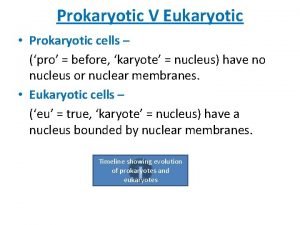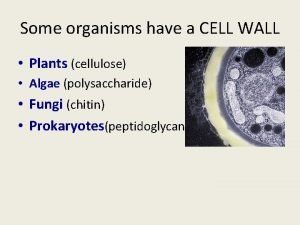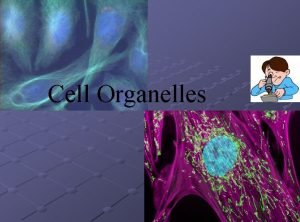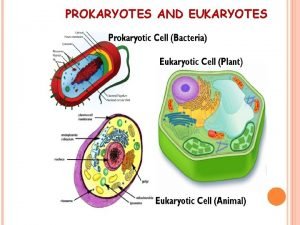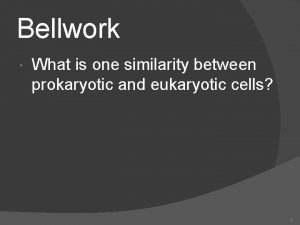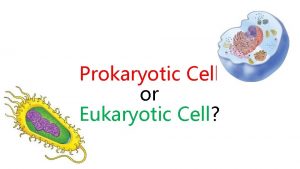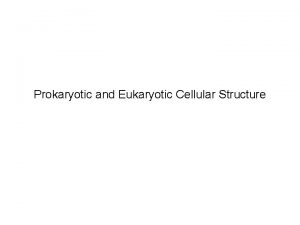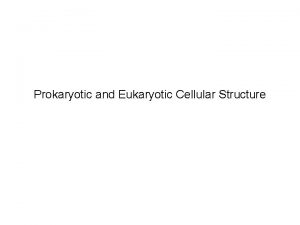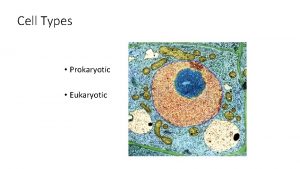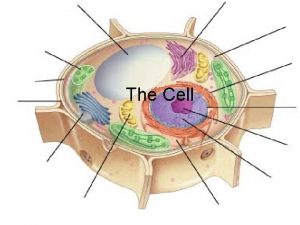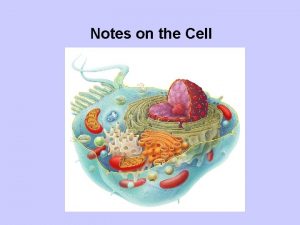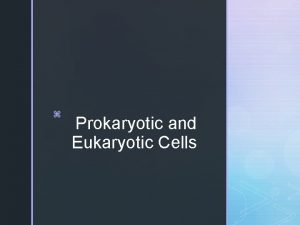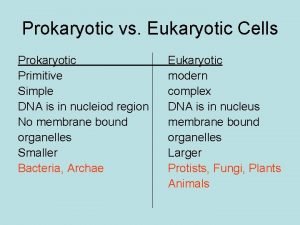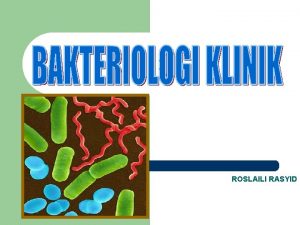A TOUR OF THE CELL Prokaryotic and eukaryotic















- Slides: 15

A TOUR OF THE CELL

Prokaryotic and eukaryotic cells differ in size and complexity Ø All cells are surrounded by a plasma membrane , contain chromosomes , and have ribosomes Ø In a eukaryotic cell, chromosomes are contained in a membrane-enclosed organelle, the nucleus. Ø In a prokaryotic cell, the DNA is concentrated in the nucleoid without a membrane separating it from the rest of the cell.

Ø Within the cytoplasm of a eukaryotic cell is a variety of membrane-bounded organelles of specialized form and function. Ø These membrane-bounded organelles are absent in prokaryotes. Ø Eukaryotic cells are generally much bigger than prokaryotic cells.

Ø A eukaryotic cell has extensive and elaborate internal membranes, which partition the cell into compartments. Ø These membranes also participate in metabolism as many enzymes are built into membranes.

The Nucleus Ø The nucleus contains most of the genes in a eukaryotic cell. Ø Some genes are located in mitochondria and chloroplasts.

Ribosomes build a cell’s proteins Ø Ribosomes contain r. RNA and protein. Ø A ribosome is composed of two subunits that combine to carry out protein synthesis. Ø Some ribosomes, free ribosomes, are suspended in the cytosol Ø Other ribosomes, bound ribosomes, are attached to the outside of the endoplasmic reticulum.

The Endomembrane System Ø The endomembrane system includes the nuclear envelope, endoplasmic reticulum, Golgi apparatus, lysosomes, vacuoles, and the plasma membrane.

The endoplasmic reticulum manufactures membranes and performs many other biosynthetic functions Ø The ER membrane is continuous with the nuclear envelope and the cisternal space of the ER is continuous with the space between the two membranes of the nuclear envelope. Ø Smooth ER looks smooth because it lacks ribosomes.

Ø Rough ER looks rough because ribosomes (bound ribosomes) are attached to the outside, including the outside of the nuclear envelope. Ø The smooth ER is rich in enzymes and plays a role in a variety of metabolic processes. Ø The smooth ER also catalyzes a key step in the mobilization of glucose from stored glycogen in the liver. Ø Other enzymes in the smooth ER of the liver help detoxify drugs and poisons.

Ø Rough ER is especially abundant in those cells that secrete proteins. Ø Rough ER is also a membrane factory. Ø Enzymes in the rough ER also synthesize phospholipids from precursors in the cytosol.

The Golgi apparatus finishes, sorts, and ships cell products Ø The Golgi apparatus is especially extensive in cells specialized for secretion. Ø the Golgi tags, sorts, and packages materials into transport vesicles.

Lysosomes are digestive compartments Ø Lysosomal enzymes can hydrolyze proteins, fats, polysaccharides, and nucleic acids. l l Lysosomes can also fuse with another organelle or part of the cytosol. This recycling, or autophagy, renews the cell. • The lysosomes play a critical role in the programmed destruction of cells in multicellular organisms. l This process allows reconstruction during the developmental process.

Vacuoles have diverse functions in cell maintenance Ø Food vacuoles , Contractile vacuoles , and Central vacuoles

Mitochondria and chloroplasts are the main energy transformers of cells Ø Mitochondria are the sites of cellular respiration, generating ATP from the catabolism of sugars, fats, and other fuels in the presence of oxygen. Ø Chloroplasts, found in plants and eukaryotic algae, are the sites of photosynthesis. Ø Mitochondria and chloroplasts grow and reproduce as semiautonomous organelles.

Mitochondria and chloroplasts are mobile and move around the cell along tracks in the cytoskeleton Ø Endosymbiotic Origin : proposed ancestors of mitochondria were aerobic heterotrophic prokaryotes AND for chloroplast were photosynthetic prokaryotes. Ø The ancestors gained entry and eventually became mutually beneficial Ø
 Linear chromosomes in eukaryotes
Linear chromosomes in eukaryotes Life
Life Prokaryotic cell vs eukaryotic cell
Prokaryotic cell vs eukaryotic cell Prokaryotic and eukaryotic cells worksheet
Prokaryotic and eukaryotic cells worksheet Diff between prokaryotic and eukaryotic cells
Diff between prokaryotic and eukaryotic cells Protien pump
Protien pump Prokaryotic cells
Prokaryotic cells Plants are multicellular eukaryotes
Plants are multicellular eukaryotes Difference between prokaryote and eukaryotes
Difference between prokaryote and eukaryotes Which organisms are prokaryotes
Which organisms are prokaryotes Prokaryotic promoter vs eukaryotic promoter
Prokaryotic promoter vs eukaryotic promoter Venn diagram of plants and animals
Venn diagram of plants and animals What are three parts of the cell theory
What are three parts of the cell theory Cytoskeletal protein
Cytoskeletal protein The oldest prokaryote is
The oldest prokaryote is Similarity between prokaryotic and eukaryotic cells
Similarity between prokaryotic and eukaryotic cells




